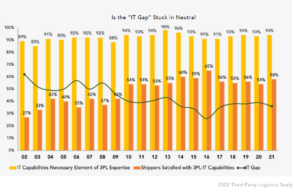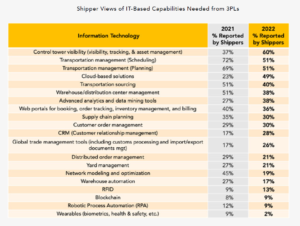
Logistics Operators Look to Data, Technology for Advantage

(Travel mania/Shutterstock)
Things are bit of a mess when it comes to logistics at the moment. We’re still feeling the ripple effects from the COVID-induced economic shutdown in early 2020, and a critical worker shortage here in the United States isn’t helping things. But in the long run, the key ingredient for reaching supply chain harmony will take a dose of big data tech, including 5G, IoT, and AI, according to the “2022 Third-Party Logistics Study” released this week.
The study, now in its 26th year, shows how data and IT play critical roles at all levels of the supply chain, including shippers, the 3PL providers that shippers subcontract with, and the customers whose goods ultimately are moved around the world by plane, ship, train, and truck.
“Real-time data within the supply chain is extremely valuable, allowing companies to get ahead of disruptions, predict peaks, and improve planning,” write the authors of the report, who work for NTT Data, Penn State, and Penske Logistics. “Data can drive more collective decision-making across informational silos that exist within shippers’ operations.”
In particular, emerging technologies like 5G and IoT “will help immensely” with improving logistics in the future, particularly when it comes to transparency, visibility, and collaboration among supply chain participants, the report says.
However, we’ve got a ways to get there. For a number of years, this particular study has been tracking what it calls the “IT Gap,” which measures the difference between the level of IT investment that shippers want and what 3PL providers currently have. The IT Gap for 2021 is 36%, a number that hasn’t changed much in over a decade (see graphic).
Shippers and 3PL use a number of technologies to automate and drive efficiency into the process of moving trillions of dollars’ worth of goods about the face of the Earth: Parcel tracking applications; supply chain planning and scheduling; warehouse management systems; yard management (not to mention general purpose accounting, CRM, and ERP systems).
The percentage of shippers asking for advanced analytics and data mining capabilities among their 3PL providers rose 11%, from 27% in the 2021 report to 38% in the 2022 report. That was middle-of-the-road in terms of changes, with control tower visibility (including visibility, tracking, and asset management) leading the pack in terms of needs.
While a number of 3PL and shipping companies abandoned ERP implementations during the current all-hands-on-deck COVID era (unless they were close to going live), that hasn’t been the case for data analytics, digital transformation, transparency, visibility, 5G/IOT, sustainability, and talent initiatives, most of which been continued during the tough times, the report’s authors write. “Ongoing development and improvement continues to be underway in these areas, despite current challenges in logistics and supply chain management,” they write.
5G/IoT initiatives are being closely monitored, particularly as they have the potential to benefit AI, machine learning, and robotics initiatives. More than half of shippers taking part in the 3PL study indicated they feel 5G technology is either moderately (35%) or critically (17%) important, according to the study. Those numbers were exceeded by 3PL providers.
“The path to success is people and machines working together,” says Andy Moses, senior vice president of sales and solutions for Penske Logistics. “Machines are uncovering large volumes of data that are very difficult for the human eye to catch, capture, and distill. Technology also allows for more visibility into the supply chain, which directly leads to better and more timely decision making.”
The ability to gather and analyze real-time data is another way technology is improving the supply chain. 3PL companies are ahead of shippers in this department, according to the study, which found 53% of 3PL providers offered real-time data to clients at least half of their clients, and another 23% could provide it to one-quarter to one-half of their clients.
“There is a very robust frontier to use data to prevent things from going wrong in the first place,” Moses stated. “It alerts everyone to few transactions among the vast sea of transactions that are out of tolerance.”
Both shippers and 3PL providers are adopting IoT technologies to enhance their businesses, the report found. For example, 63% of 3PL providers say they’re adopting IoT to improve productivity, while 57% say they’re using it to improve real-time decision making and to create a competitive differentiation in the market.
3PL providers are also leading their shipping brethren when it comes to cloud adoption, with 41% of 3PL providers saying they’re adopting private cloud compared to 33% of shippers, and 18% of 3PL providers saying they’re adopting public cloud versus 12% of shippers, the study found.
3PLs are also leading shippers when it comes to adopting cloud-based applications, including transformation management systems, order management systems, labor management systems, and warehouse management systems. However, shippers are leading 3PLs with the rollout of sales and operations planning (S&OP) and integrated operations planning (IBP), demand planning, and supply planning.
Despite a driver and worker shortage that is responsible for a 73-ship backlog this week at the Los Angeles and Long Beach ports, there doesn’t seem to be a rush among 3PLs and shippers to put robots behind the wheels of trucks and forklifts.
“Within the study, the majority of both groups show little interest in investing in autonomous trucks or autonomous yard jockeys currently,” the study says. Maybe next year.
Related Items:
Sourcing Bots Bid to Keep Freight Moving
How Coke Bottlers Save Millions with AI
How Big Data Can Optimize Global Shipping

































